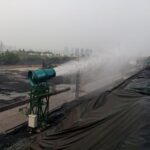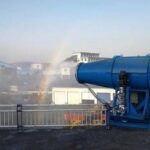Dust suppression machine is specialized equipment designed to control and minimize airborne dust in industrial and commercial settings. It typically uses fine water mist or atomized sprays to capture dust particles, making them too heavy to remain airborne. These machines come in different sizes and designs, ranging from compact small units to large stationary systems that can cover vast areas. These devices are designed to tackle dust generated during material handling, demolition, excavation, or processing. By reducing dust levels, they protect workers from respiratory hazards, prevent equipment degradation, and mitigate environmental pollution. The evolution of dust suppression technology has led to more efficient, eco-friendly, and cost-effective solutions that cater to diverse industrial needs.
Working Principle of Fog Cannon Dust Suppression
The operation of a dust suppression machine is based on atomization and particle binding. Here is a step-by-step explanation of its working principle:
- Water Supply: Water is pumped into the machine at high pressure.
- Atomization: Specialized nozzles or rotary cannons break the water into ultra-fine droplets.
- Dust Capture: These micro-droplets collide with airborne dust particles, binding them together.
- Gravity Effect: The heavier particles fall to the ground, preventing them from remaining suspended in the air.
- Continuous Operation: With adjustable spray ranges, the machine can cover small or large areas continuously.
Advantages of Using A Mist Cannon for Dust Suppression
The benefits of using a dust suppression machine extend far beyond simply cleaning the air.
- Improved Health and Safety: This is the primary advantage. Airborne dust, especially fine particulate matter, can be a serious health hazard, leading to respiratory illnesses like asthma, bronchitis. By effectively capturing and settling dust, these machines significantly reduce the risk of inhalation for workers and the public.
- Enhanced Equipment Longevity: Dust is abrasive and can cause significant wear and tear on machinery. By keeping the air clean, it protects sensitive components, filters, and engines, reducing maintenance costs and extending the lifespan of valuable equipment.
- Environmental Protection: Dust can contaminate soil and water sources, harming local flora and fauna. By preventing dust from migrating off-site, these machines help protect the local ecosystem and ensure compliance with environmental regulations.
- Increased Productivity: A dusty work environment can be uncomfortable and hazardous, leading to lower morale and reduced productivity. A clean, safe workspace not only boosts worker well-being but also allows operations to proceed.
Applications and Use Cases
Dust suppression machines are incredibly versatile and can be used in a wide range of industries and applications.
- Construction and Demolition: These are classic use cases. Cutting concrete, breaking up asphalt, and general demolition all create massive amounts of dust. It can be positioned to spray a fine mist over the work area, capturing dust at the source and preventing it from becoming a problem.
- Mining and Quarrying: Open-pit mining and quarrying operations generate vast clouds of dust from crushing, conveying, and hauling materials. Large-scale dust suppression machines are essential for these sites to protect workers, equipment, and surrounding communities.
- Waste and Recycling Facilities: Sorting and processing waste materials often stir up dust and other airborne particles. Dust suppression systems are used to control these emissions, making the facility safer and more hygienic.
- Bulk Material Handling: From grain silos to coal terminals, the loading and unloading of bulk materials can release significant dust. The equipment can be integrated into the process to control dust at conveyor transfer points and during loading.
How to Choose the Right Dust Suppression Machine?
Selecting the best fog cannon dust suppression depends on several factors:
- Application: Determine whether you need it for mining, construction, agriculture, or other sectors.
- Coverage Area: Choose a machine with the appropriate spray distance and coverage capacity.
- Water Supply: Consider machines designed to optimize water use, especially in water-scarce regions.
- Portability: Decide between stationary, trailer-mounted, or truck-mounted machines depending on mobility needs.
- Budget and Maintenance: Factor in both initial investment and long-term operating costs.



